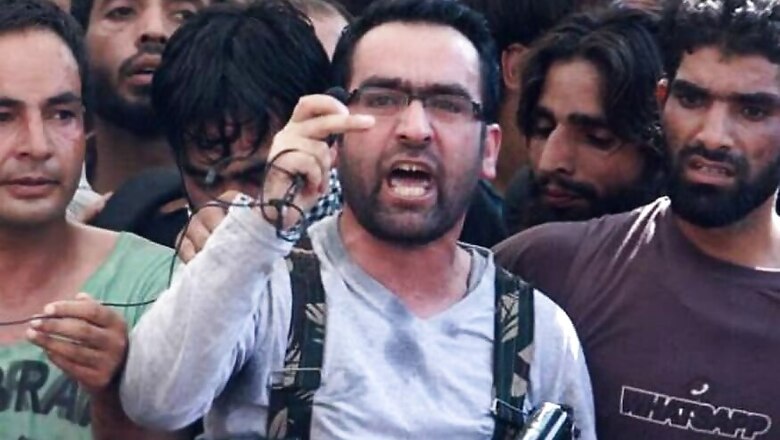
views
Late in the summer of 2016, as a great tide of Islamist protest washed over southern Kashmir, sweeping aside the Indian state and turning large swathes of territory into liberated zones, thousands of children, women and men assembled in the small central Kashmir village of Nyaina-Bandina for the funeral rites of Hizb-ul-Mujahideen jihadist Shariq Ahmad Bhat. Fevered, the crowd fought for a glimpse of his body and to tear off parts of his clothing — the kind of ecstatic reverence usually reserved for a venerated saint.
Then, a bespectacled, slight young man in a white shirt raised the Kalashnikov rifle he had been cradling in his arms and fired a burst into the sky.
From then to his death in a shootout on Wednesday, Riyaz Naikoo rose to be the best known face of the Hizb-ul-Mujahideen in Kashmir, appearing in hundreds of Facebook posts or through WhatsApp messages, broadcasting retribution against informers, demanding police officers resign from their jobs, and threatening annihilation to India.
But even though Naikoo was the Hizb-ul-Mujahideen’s longest-serving division commander in Kashmir, he ultimately failed to turn the uprising of 2016, the biggest Islamist mobilisation in decades, into a platform to expand the Hizb-ul-Mujahideen’s power. His rise and fall tells us important things about the limits of jihadist power and influence in Kashmir.
Next generation of terrorists
Like so many mid-level commanders in Kashmir’s jihadist movement, Naikoo was part of a cohort of educated young people drawn to political Islam by the bruising communal movements that began to sweep 2008. Like the overwhelming majority of those recruited by jihadist groups after this time, he never received formal combat training — a sharp break from an earlier generation of terrorists instructed at camps in Pakistan-occupied Kashmir.
Born in 1986 to Zeba and Asadullah Naikoo, Naikoo grew up in Beighpora, near the central Kashmir town of Awantipora. His father, a small peasant, also ran a tailor’s shop.
Like so many farming families in Kashmir, the couple invested in education, hoping it would help their children claw their way into the middle class. Naikoo’s younger brother is completing the final year of his Bachelor of Arts degree and his sister is also a student.
For most of his early years, it appeared Naikoo would go down the road his parents hoped for. Following education at government schools in Beighpora and Gulzarpora, he graduated with a respectable 462 out of 600, and then secured a degree from the Degree College in Pulwama.
The only job Naikoo could find, though, was at the Hanfia Model School in Malangpora, an institution run by a pietist Islamic trust. In addition to teaching arithmetic, Naikoo began delivering lectures on Islam.
In 2010, massive street violence — which would go on to claim the lives of 112 protesters — broke out after a rogue Indian Army unit killed three residents of the village of Nadihal in northern Kashmir and sought to pass them off as terrorists killed in an encounter. The violence came just two years after the communally-charged Amarnath Shrine Board agitation had also claimed the lives of dozens of young people who had taken on Indian forces in pitched battles on the streets.
Like hundreds of other young people in the Awantipora area, Naikoo was arrested on charges of participating in mobs throwing rocks at police. In prison, police sources say, his life changed.
Naikoo's entry into the Hizb
Early in June 2012, Naikoo borrowed Rs 7,000 from his parents, saying he needed it to apply for a postgraduate degree — and disappeared. He was, police believe, drawn into the Hizb-ul-Mujahideen by Sajjad Mir, a resident of Litter in Pulwama, who was then serving as the terrorist group’s commander and financial head for south Kashmir. Mir, alleged to be responsible for the killing of Kulpora village sarpanch Ghulam Mohammad Bhat and Indian Army soldier Mehraj-ud-Din was himself shot dead by the police in 2013.
The period was critical for the Hizb-ul-Mujahideen. Even though a new generation of young people had been radicalised by the street violence of 2010 and 2012, recruitment was at record lows: just 23 people, police records show, joined the Hizb in 2011, down from 54 in 2010, and 110 five years earlier, in 2006.
In the year Naikoo joined the Hizb-ul-Mujahideen, 2012, just 20 others were recruited by jihadist groups; the next year, the number would drop even lower, to 16.
Low recruitment, and the steady elimination of mid-level commanders like Naikoo’s mentor, Mir, allowed the schoolteacher-turned-jihadist to rise through the ranks of the Hizb-ul-Mujahideen far faster than he might otherwise have done.
Perhaps more important, it placed Naikoo in a position of authority when jihadist recruitment again began to climb from 2014 — helped along by former chief minister Mehbooba Mufti’s orders to police to cut back operations targeting overground sympathisers and supporters of jihadist groups. From 53 in 2014, jihadist recruitment grew in successive years to 66, 88 and then 128.
In 2016, when protests sparked off by the killing of jihadist icon Burhan Wani sparked off the largest mobilisation against India since the early 1980s, the state collapsed in large swathes of southern Kashmir. For all practical purposes, Naikoo became the emperor of the military apparatus which ruled this liberated zone.
The young divisional commander demonstrated considerable skill at propaganda, re-instituting gun salutes for slain jihadists at their burials, and using social media to tell the stories of young recruits to its ranks.
Ensuring the Hizb-ul-Mujahideen’s supremacy, though, wasn’t easy. Wani had broken away from the Hizb, charging Pakistan’s intelligence services with opportunism, and accusing the secessionist politicians of the All Parties Hurriyat Conference with treachery. Naikoo tried to heal the wounds, but to little effect.
The strains deepened after Wani’s successor, Zakir Rashid Bhat, along with south Kashmir Lashkar-e-Taiba commander Abu Dujanah, set up a new breakaway group that would evolve into al-Qaeda affiliated Ansar Ghazwa’tul Hind.
Naikoo demonstrated considerable political skill, ensuring the Hizb-ul-Mujahideen’s young recruits stayed committed to their group despite the social media visibility of the new, more radical organisation. He studiously avoided attacks on fellow jihadists — but made clear, to the Hizb’s rank and file, that the Ansar Ghazwa’tul Hind’s anti-Pakistan position would ensure it was cut off from resources, and annihilated.
Even as the rival organisation haemorrhaged cadre and commanders, and found itself short of both weapons and cash, the Hizb-ul-Mujahideen slowly rebuilt itself across Kashmir.
Hizb's future unclear
For all the hype surrounding Naikoo’s career though, the Hizb-ul-Mujahideen’s future is still unclear. Even though last week’s killing of five security force personnel, including 21 Rashtriya Rifles commanding officer Colonel Ashutosh Sharma, has raised concerns over heightened infiltration across the Line of Control, there’s little evidence Pakistan has reversed the tapering-off of support to jihadists it implemented after the air strike on Balakot last year.
Last year, intelligence data obtained by News18 shows an estimated 219 jihadists crossed the Line of Control into Kashmir, down from 328 in 2018, and 419 in 2017. This year so far, intelligence services estimate the levels remain similar to those seen in the winter of 2019.
That means the ill-trained recruits brought into the Hizb-ul-Mujahideen — some 35 of whom joined the group since January — suffer from chronic shortages of weapons and ammunition. In addition, they lack the training to effectively operate independently of foreign-trained jihadists from Pakistan who, in turn, have been unable to stage a single major operation since the Pulwama bombing last year.
Little evidence exists for media claims that foreign jihadists are better trained than in the past, either. Last week’s tragic killing of Colonel Sharma and four others, for example, came about because stood in front of a home where terrorists were hiding out on the first floor — an error of judgment, rather than a combat defeat.
Indeed, levels of violence from January to April this year, measured by the killing of Indian security force personnel, jihadists and incidents, are similar to those seen in the same months of 2019, government data shows.
Naikoo’s success was to ensure the Hizb-ul-Mujahideen was able to expand its wellspring of support in society, retaining its status as the predominant ethnic-Kashmir in the face of challenges from globalist organisations like al-Qaeda. He wasn’t, however, able to resolve its core weaknesses: complete dependence on Pakistan. Today, by most intelligence estimates, the group he commanded, once Kashmir’s largest, has some 75 cadre, to the over-100 of the Lashkar-e-Taiba, and the 50-odd of the Jaish-e-Muhammad.
Put simply, hopes among Kashmiri Islamists of a significant revival of the jihadist movement after the 2016 uprising have proved illusory. Even though anger against India remains substantial, this doesn’t in itself translate into a more powerful jihadist movement.
The future of the Kashmir jihad will depend not on the local commander who succeeds Naikoo, but the generals in the Inter-Services Intelligence Directorate headquarters in Rawalpindi’s Aabpara.
Ever since the Balakote attacks, the generals have held on to their cards, fearing war with India. Naikoo died waiting for them to call their bets.




















Comments
0 comment